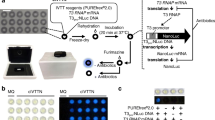Abstract
This article describes a paper-based low cost single cell HaloChip assay that can be used to assess drug- and radiation-induced DNA damage at point-of-care. Printing ink on paper effectively blocks fluorescence of paper materials, provides high affinity to charged polyelectrolytes, and prevents penetration of water in paper. After exposure to drug or ionizing radiation, cells are patterned on paper to create discrete and ordered single cell arrays, embedded inside an agarose gel, lysed with alkaline solution to allow damaged DNA fragments to diffuse out of nucleus cores, and form diffusing halos in the gel matrix. After staining DNA with a fluorescent dye, characteristic halos formed around cells, and the level of DNA damage can be quantified by determining sizes of halos and nucleus with an image processing program based on MATLAB. With its low fabrication cost and easy operation, this HaloChip on paper platform will be attractive to rapidly and accurately determine DNA damage for point-of-care evaluation of drug efficacy and radiation condition.

Single cell HaloChip on paper






Similar content being viewed by others
References
Fedier A, Fink D. Mutations in DNA mismatch repair genes: implications for DNA damage signaling and drug sensitivity (review). Int J Oncol. 2004;24(4):1039–47.
Frankenberg-Schwager M. Review of repair kinetics for DNA damage induced in eukaryotic cells in vitro by ionizing radiation. Radiother Oncol J Eur Soc Ther Radiol Oncol. 1989;14(4):307–20.
Zhang P, Qiao Y, Wang C, Ma L, Su M. Enhanced radiation therapy with internalized polyelectrolyte modified nanoparticles. Nanoscale. 2014;6(17):10095–9.
Wan J, Johnson M, Schilz J, Djordjevic MV, Rice JR, Shields PG. Evaluation of in vitro assays for assessing the toxicity of cigarette smoke and smokeless tobacco. Cancer Epidemiol Biomarkers Prev. 2009;18(12):3263–304.
Fenech M. The advantages and disadvantages of the cytokinesis-block micronucleus method. Mutat Res. 1997;392(1–2):11–8.
Watanabe M, Hitomi M, van der Wee K, Rothenberg F, Fisher SA, Zucker R, et al. The pros and cons of apoptosis assays for use in the study of cells, tissues, and organs. Microsc Microanal. 2002;8(5):375–91.
Nusse M, Marx K. Flow cytometric analysis of micronuclei in cell cultures and human lymphocytes: advantages and disadvantages. Mutat Res. 1997;392(1–2):109–15.
Slamenova D, Gabelova A, Ruzekova L, Chalupa I, Horvathova E, Farkasova T, et al. Detection of MNNG-induced DNA lesions in mammalian cells; validation of comet assay against DNA unwinding technique, alkaline elution of DNA and chromosomal aberrations. Mutat Res. 1997;383(3):243–52.
Wood DK, Weingeistb DM, Bhatia SN, Engelwardb BP. Single cell trapping and DNA damage analysis using microwell arrays. Proc Natl Acad Sci U S A. 2010;107:10008–13.
Gichner T, Mukherjee A, Wagner ED, Plewa MJ. Evaluation of the nuclear DNA diffusion assay to detect apoptosis and necrosis. Mutat Res. 2005;586(1):38–46.
Sestili P, Martinelli C, Stocchi V. The fast halo assay: an improved method to quantify genomic DNA strand breakage at the single-cell level. Mutat Res. 2006;607(2):205–14.
Yu WW, White IM. Inkjet-printed paper-based SERS dipsticks and swabs for trace chemical detection. Analyst. 2013;138(4):1020–5.
Martinez AW, Phillips ST, Wiley BJ, Gupta M, Whitesides GM. FLASH: a rapid method for prototyping paper-based microfluidic devices. Lab Chip. 2008;8(12):2146–50.
Zhou M, Yang M, Zhou F. Paper based colorimetric biosensing platform utilizing cross-linked siloxane as probe. Biosens Bioelectron. 2014;55:39–43.
Jokerst JC, Adkins JA, Bisha B, Mentele MM, Goodridge LD, Henry CS. Development of a paper-based analytical device for colorimetric detection of select foodborne pathogens. Anal Chem. 2012;84(6):2900–7.
Yang X, Forouzan O, Brown TP, Shevkoplyas SS. Integrated separation of blood plasma from whole blood for microfluidic paper-based analytical devices. Lab Chip. 2012;12(2):274–80.
Miranda BS, Linares EM, Thalhammer S, Kubota LT. Development of a disposable and highly sensitive paper-based immunosensor for early diagnosis of Asian soybean rust. Biosens Bioelectron. 2013;45:123–8.
Pelton R. Bioactive paper provides a low-cost platform for diagnostics. Trends Anal Chem. 2009;28(8):925–42.
Hu J, Wang S, Wang L, Li F, Pingguan-Murphy B, Lu TJ, et al. Advances in paper-based point-of-care diagnostics. Biosens Bioelectron. 2014;54:585–97.
Jefferies R, Ryan UM, Irwin PJ. PCR-RFLP for the detection and differentiation of the canine piroplasm species and its use with filter paper-based technologies. Vet Parasitol. 2007;144(1–2):20–7.
Cheng CM, Martinez AW, Gong J, Mace CR, Phillips ST, Carrilho E, et al. Paper-based ELISA. Angew Chem. 2010;49(28):4771–4.
Juvonen H, Maattanen A, Lauren P, Ihalainen P, Urtti A, Yliperttula M, et al. Biocompatibility of printed paper-based arrays for 2-D cell cultures. Acta Biomater. 2013;9(5):6704–10.
Derda R, Tang SKY, Laromaine A, Mosadegh B, Hong E, Mwangi M, et al. Multizone paper platform for 3D cell cultures. PLoS One. 2011;6(5):1–14.
Qiao Y, Wang C, Su M, Ma L. Single cell DNA damage/repair assay using HaloChip. Anal Chem. 2012;84(2):1112–6.
Hossain M, Luo Y, Sun Z, Wang C, Zhang M, Fu H, et al. X-ray enabled detection and eradication of circulating tumor cells with nanoparticles. Biosens Bioelectron. 2012;38:348–54.
Otsu N. A threshold selection method from gray-level histograms. IEEE Trans Syst Man Cybern B Cybern. 1979;9:62–6.
Acknowledgments
This work has been supported by a New Investigator Award from Bankhead-Copley Cancer Research Program and a seed grant from Kennedy Space Center to Liyuan Ma. This work is partially supported by a Director’s New Innovator Award from National Institute of Health (NIH) to Ming Su (1DP2EB016572).
Author information
Authors and Affiliations
Corresponding author
Ethics declarations
Conflict of interest
The authors declare that there is no potential conflict of interest.
Rights and permissions
About this article
Cite this article
Ma, L., Qiao, Y., Jones, R. et al. Single cell HaloChip assay on paper for point-of-care diagnosis. Anal Bioanal Chem 408, 7753–7759 (2016). https://doi.org/10.1007/s00216-016-9872-6
Received:
Revised:
Accepted:
Published:
Issue Date:
DOI: https://doi.org/10.1007/s00216-016-9872-6



